It is almost certain that what is going to lead you to visit Tarazona, a historic enclave in the northwest of the province of Zaragoza, it's not long ago restored Mudejar cathedral, but the truth is that this Aragonese town has other cultural and heritage attractions that I have had the opportunity to discover on a recent trip.
I'll just tell you that Tarazona, due to its geographically strategic position between Castilla, Aragon y Navarre, has been an important enclave in medieval times, which is best reflected in its imposing cathedral.
However Tarazona It also has a medieval neighborhood which is located on a hill, with remains of its old wall, full of alleys, passages and striking hanging houses.
All the information in detail
What to see on the Tarazona tourism visit
It also has an old Jewish neighborhood, and notable monuments such as the Episcopal palace and church of the madeleine, and now in the most modern area of the town, a very curious bullring of the eighteenth century.
The fact that a great cathedral is the best exponent of the strategic importance that Tarazona in the 12th century, when the town was located on the aforementioned hill surrounded by a wall.
Tarazona Cathedral
Consecrated in 1235, it should be noted that the Tarazona Cathedral It was built at the same time as the cathedrals of Toledo and Burgos.
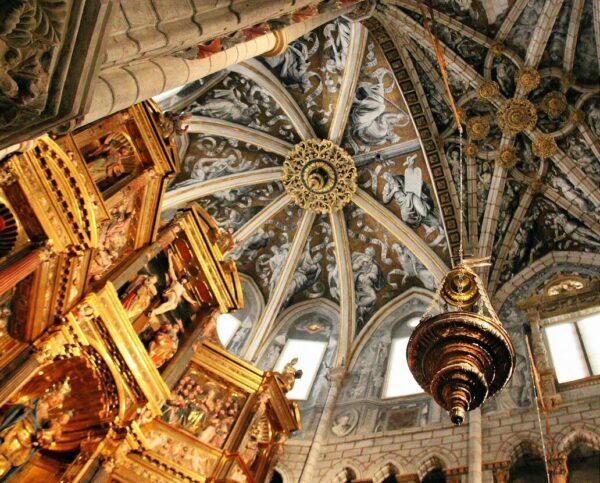
After suffering serious damage at the end of the 14th century, it was at the end of the 15th century when the building was rebuilt in Moorish style, and in the 16th century its interior was redecorated in Renaissance style.
Here you have all the extensive information and Tips for visiting the Tarazona Cathedral.
Medieval neighborhood of Cinto in Tarazona
When during your Tarazona visit, to the north of Aragon, walk the narrow streets of the old Jewry and medieval neighborhood of Cinto, you will understand why the romantic poet Gustavo Adolfo Becquer called it the "little Toledo» after your stay.
As we have already mentioned, historically Tarazona It has always been border land, now on the borders of the communities of Aragón, Navarra and Castilla y León.
Its mix of cultures dates back to its creation by the Celtiberians, and its colonization by the Romans in the 1st century, when they called it Turiaso.

Tarazona It was considered an episcopal seat as early as the 5th century, and the construction of the aforementioned cathedral is a good example of the importance it has had in history.
From the shore of Queiles River You start your walk, first, through the blocks of the old neighborhood of the Jewry, now belonging to the Sefarad network.
Then, after passing under the surprising hanging houses of Tarazona, you arrive at the entrance door of the medieval quarter. next to the buildings Episcopal palace and Magdalena Church.
In the narrow streets of Cinto neighborhood, Together with Jewry, in the process of heritage recovery, with its various corners, porches and landscapes, it is easy for you to feel transported to medieval times.
From the gazebo that is next to the wall you will have the best panoramic views of Tarazona.

Episcopal Palace of Tarazona
And in the panoramic view of ancient Tarazona that you can enjoy from the Queiles River, at the foot of the hill where the old medieval area is located, the Renaissance-style façade of the Episcopal palace, which can be distinguished along with the bell tower of the aforementioned church of the madeleine.
But going up from the Jewish quarter, the first thing you will see of Episcopal palace It is an imposing stone structure, a reflection of its origins as a castle, both from the Christian and Muslim periods, with archaeological remains dating back to Roman times.
It was after the War of the two Pedros, which has so marked the history of Tarazona, when the then archbishop of the city, Pedro Pérez Calvillo, decided to build a new archiepiscopal palace.
It was in the year 1386 when the old Zuda, a Muslim fortress where the military governors resided during the occupation, to turn it into their residence.
On top of the stone structure, in the upper part of the building, a new structure was built, but really the Episcopal palace It was not completed until almost 200 years later, in the mid-XNUMXth century, in a Renaissance architectural style.
ORGANIZE your TRIP
- Don't forget your TRAVEL INSURANCE with a 5% discount
- Book the HOTEL for your trip
- RENT a CAR for your trip
- The best TOURS and EXCURSIONS in Spanish
- NO-LINE TICKETS for museums and monuments
- Best FREE TOURS around the world
- Book your TRANSFER from the airport
- eSIM card with INTERNET at the best price
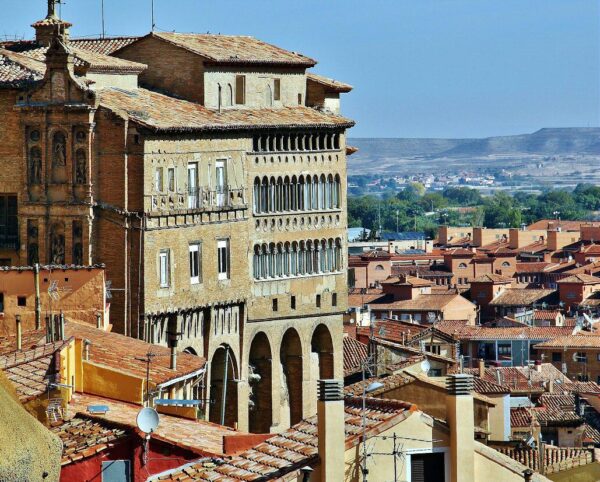
At that time, the large corridor was built with arches that protrude from the rocky cliff, a façade that is the most characteristic image of the building.
Used from then until 2006 as the residence of the bishops of Tarazona, in 2008 the palace was reopened to public visits by Monumental Tarazona, the foundation created to restore the cultural heritage of this Aragonese town.
What to see when visiting the Episcopal Palace
In your visit of the Episcopal Palace, you will enter through a Renaissance courtyard and go up the Noble Staircase to the second floor, after passing by the door of the room where the bishop resided.
On this staircase your attention will be caught by its large dome decorated with Renaissance elements, including sculpture.
Surely you will stop at the arches of the long corridor of the main façade, from where you have the best panoramic views of Tarazona and the nearby Moncayo.
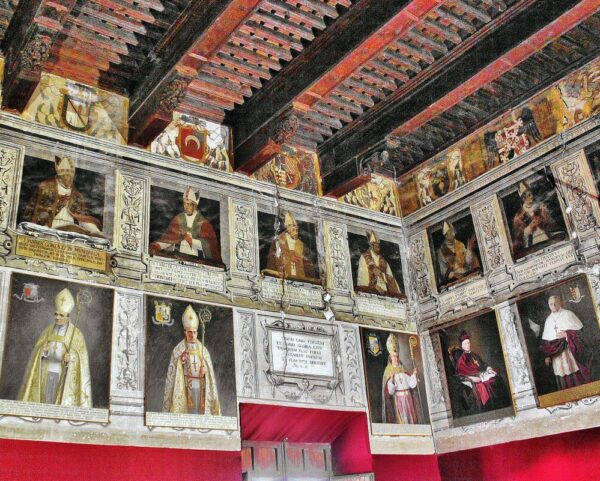
And now is when you will arrive at the main room of the palace, one of the most surprising corners of Tarazona, the imposing Bishops' Hall.
On its walls there are frescoes with portraits of all the bishops that the city has had during its history. The precedent for this gallery of portraits is the series of popes painted in the Sistine Chapel of the Vatican.
This large room, with a wooden ceiling, is awaiting restoration, which you will see by the cracks in some of the walls.
In a small adjoining room, paintings with portraits of the most recent bishops of Tarazona, which are located there because there is no longer space in the aforementioned large Bishops' Hall.
Likewise, I want to highlight the small chapel next to the aforementioned room, with its walls decorated with frescoes.
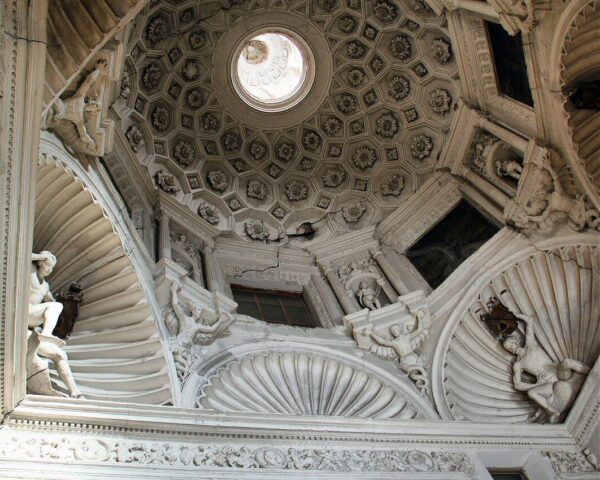
Schedule to visit the Episcopal Palace of Tarazona
Here you can consult the Visiting hours of the Episcopal Palace of Tarazona which from Tuesday to Sunday are from 11 a.m. to 13 p.m., and Saturdays, Sundays and holidays, from 11 a.m. to 14 p.m. and from 16 p.m. to 18 p.m.
El price of admission It is 1,50 euros, with free admission for children under 6 years old.
Magdalena Church in Tarazona
The most emblematic church of Tarazona is that of the cupcake, a building located inside the walled enclosure, and whose bell tower is now part of the most typical panoramic image of the town.

In front of the entrance of archiepiscopal palace the so-called opens palace square, with a viewpoint, and on top of it stands the aforementioned building of the church of the madeleine, currently an exponent of the Mudejar architecture.
Later, in the 17th century, it was reformed again in mannerist style.
When you enter the interior of the Magdalena church you will see the strange result of so much reform.
To begin with, the interior maintains the distribution of three naves, but the one at the back has a totally different decoration from the rest.
On the one hand, it maintains the austere Romanesque apse, while the ceiling shows us a paneling which was brought to light in the 60s.
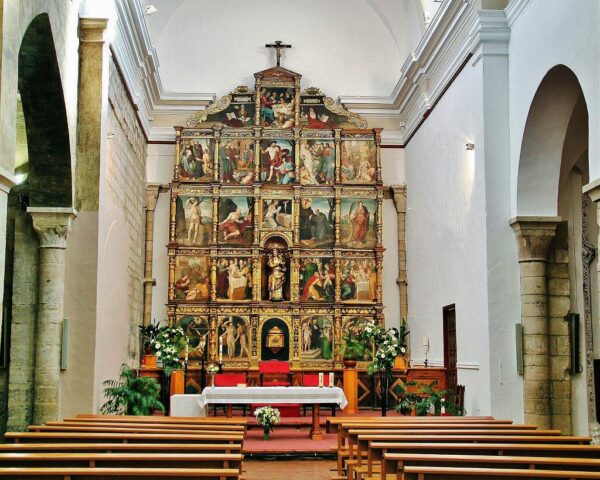
And the other two naves have the typical white walls of a baroque church, the result of the reform carried out in the 17th century.
Don't forget your Travel Insurance
Are you organizing your trip or getaway? Don't leave without take out your travel insurance before, and here we explain why. If you hire it with us, you have a 5% discount
Apart from the aforementioned apse, other notable elements inside the church are the mudejar lectern from the 16th century (large wooden lectern to support singing books) and the altarpiece from the same century.
In a prominent location the image of Saint Atilan, patron saint of Tarazona, whose relics arrived in the town on August 28, 1968.
As a curiosity, it is every August 28 when the patron saint's festivities are celebrated, and not on the saint's day, which is October 5.
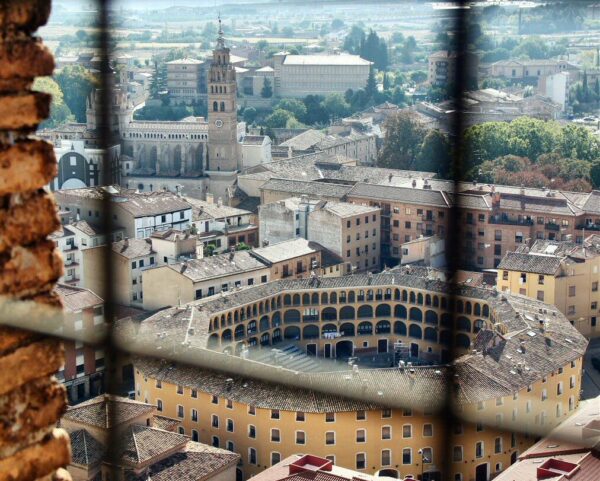
How to climb the tower of the Magdalena church
Tu visit of the Magdalena church It will be incomplete if you do not climb to the top of the bell tower. With a Romanesque base of the original 12th century building, as you climb you can see the successive growth of the tower.
A first spire It was located at the top of the tower in 1610, but the current four-story one dates from 1963.
In the winter season you cannot climb the bell tower, since it is not sufficiently well equipped for visits.
But if during your Tarazona visit you have the opportunity to go up, you will enjoy some excellent panoramic views of this historic town, with the foreground of the Old bullring, as well as the nearby Mount Moncayo.

Tarazona Old Bullring
Regarding the aforementioned Old bullring, stopped fulfilling its function for bullfighting events in 1868, when it was replaced by the current Tarazona bullring.
It was finished being restored in 1998 and you will see that, in reality, it is a octagonal residential building with a large central patio, which was the bullring, but you may be curious to know that it was like this from the beginning.
The bullring of Tarazona It was built at the end of the 1792th century, specifically, in XNUMX.
It was around that time that stable bullrings began to be built in Spain, as bullfighting events were usually held in the town hall squares, which were fenced off for the occasion.
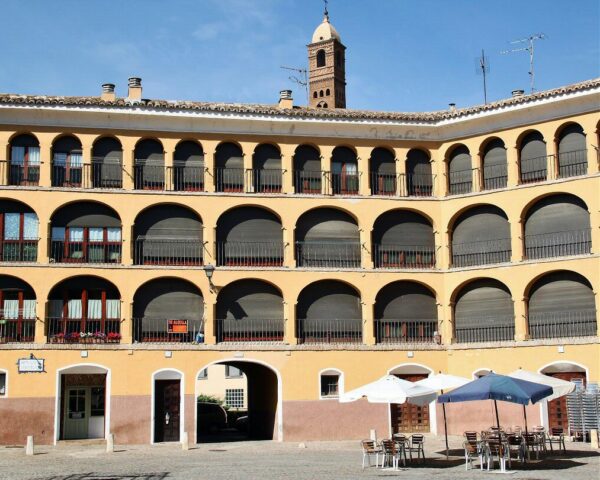
With capacity for 5.500 spectators for a population of around 9.000 inhabitants at the time, its construction meant Tarazona the definitive expansion of the population outside the limits of the historic medieval area.
From the beginning, 32 three-story homes were built, three on each side of the octagon (every two arches), and eight more on the exterior chamfers.
Access to the interior of the square and the old arena is through four passages, opposite each other two by two.
Soon, the arcades were covered by bricks to gain surface area for the homes, once they lost their function as viewpoints, when the owners stopped allowing public access.
Book your hotel, 15% discount, free cancellation
When planning your trip, we advise you to, well in advance, Book your hotel now on booking.com where you can find discounts from 15% and you will have a possible cancellation for free
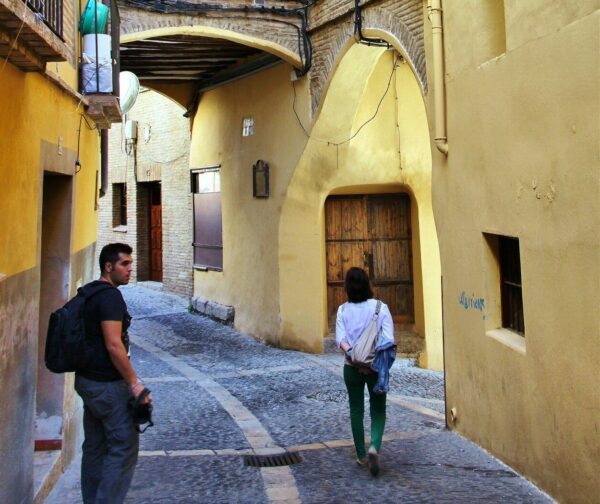
Finally, because the arena remained small, among other reasons, the construction of a new plaza was undertaken to replace it. Not a hundred years had passed. Since then, it has housed the livestock market.
In the restoration carried out at the end of the last century in the Tarazona Old Bullring, the balconies were opened again and uniformity was given to the interior facades, recovering the albero color.
This has allowed us to recover the original bullfighting atmosphere, compared to the appearance that the square had in recent times, when it was used as a mere car park.
Currently, the old bullring, from which the cars have disappeared, is used for cultural and festive activities.


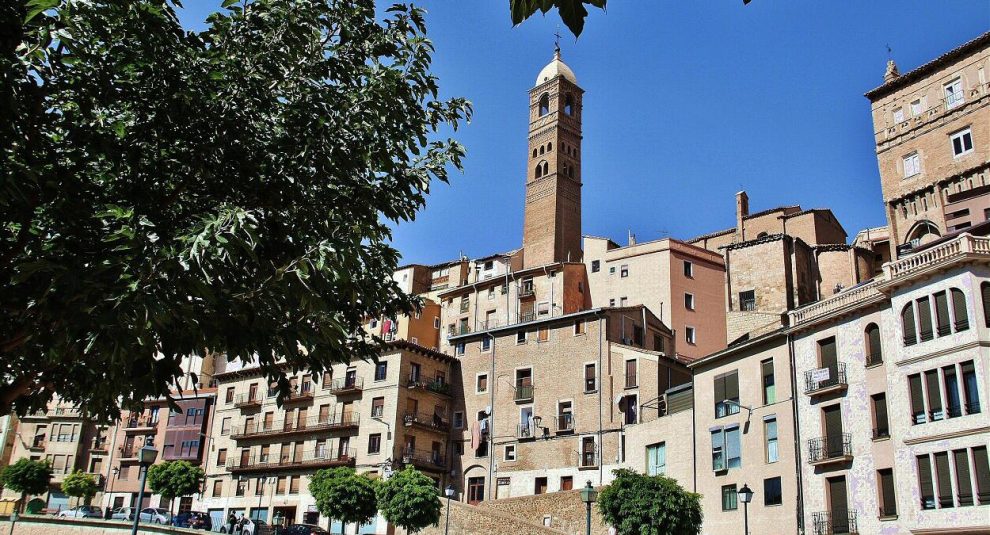

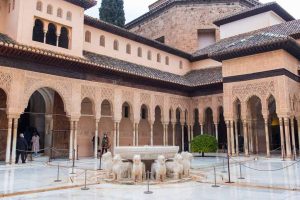
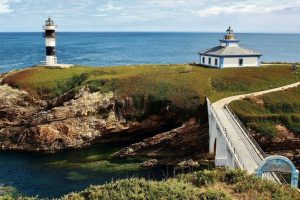











Thank you friends, for the Facebook link, I always enter your blog, the photos are very good. I really like photography? and the history, I am a fan of the elderly, I miss the photo, the superb history of the façade of the town hall, “the entry into Aachen of Emperor Charles”,,, excuse my impertinence, many GREETINGS,,,,Angel Mountain range,,,
Angel, I plan to publish it when I publish the topic about the Tarazona town hall :)